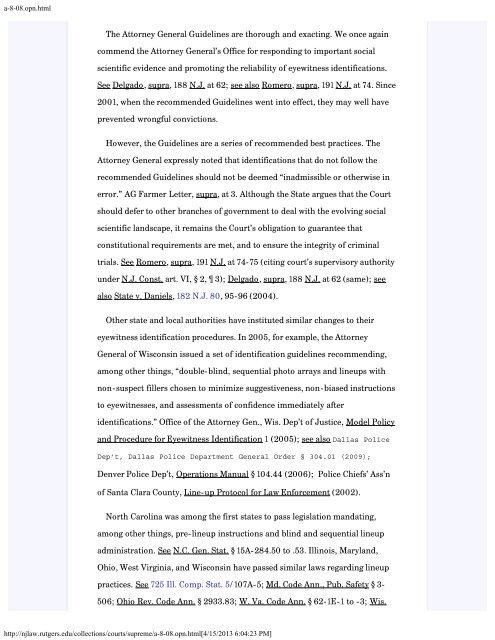State v. Henderson and the New Model Jury Charges - New Jersey ...
State v. Henderson and the New Model Jury Charges - New Jersey ...
State v. Henderson and the New Model Jury Charges - New Jersey ...
Create successful ePaper yourself
Turn your PDF publications into a flip-book with our unique Google optimized e-Paper software.
a-8-08.opn.html<br />
The Attorney General Guidelines are thorough <strong>and</strong> exacting. We once again<br />
commend <strong>the</strong> Attorney General’s Office for responding to important social<br />
scientific evidence <strong>and</strong> promoting <strong>the</strong> reliability of eyewitness identifications.<br />
See Delgado, supra, 188 N.J. at 62; see also Romero, supra, 191 N.J. at 74. Since<br />
2001, when <strong>the</strong> recommended Guidelines went into effect, <strong>the</strong>y may well have<br />
prevented wrongful convictions.<br />
However, <strong>the</strong> Guidelines are a series of recommended best practices. The<br />
Attorney General expressly noted that identifications that do not follow <strong>the</strong><br />
recommended Guidelines should not be deemed “inadmissible or o<strong>the</strong>rwise in<br />
error.” AG Farmer Letter, supra, at 3. Although <strong>the</strong> <strong>State</strong> argues that <strong>the</strong> Court<br />
should defer to o<strong>the</strong>r branches of government to deal with <strong>the</strong> evolving social<br />
scientific l<strong>and</strong>scape, it remains <strong>the</strong> Court’s obligation to guarantee that<br />
constitutional requirements are met, <strong>and</strong> to ensure <strong>the</strong> integrity of criminal<br />
trials. See Romero, supra, 191 N.J. at 74-75 (citing court’s supervisory authority<br />
under N.J. Const. art. VI, § 2, 3); Delgado, supra, 188 N.J. at 62 (same); see<br />
also <strong>State</strong> v. Daniels, 182 N.J. 80, 95-96 (2004).<br />
O<strong>the</strong>r state <strong>and</strong> local authorities have instituted similar changes to <strong>the</strong>ir<br />
eyewitness identification procedures. In 2005, for example, <strong>the</strong> Attorney<br />
General of Wisconsin issued a set of identification guidelines recommending,<br />
among o<strong>the</strong>r things, “double-blind, sequential photo arrays <strong>and</strong> lineups with<br />
non-suspect fillers chosen to minimize suggestiveness, non-biased instructions<br />
to eyewitnesses, <strong>and</strong> assessments of confidence immediately after<br />
identifications.” Office of <strong>the</strong> Attorney Gen., Wis. Dep’t of Justice, <strong>Model</strong> Policy<br />
<strong>and</strong> Procedure for Eyewitness Identification 1 (2005); see also Dallas Police<br />
Dep’t, Dallas Police Department General Order § 304.01 (2009);<br />
Denver Police Dep’t, Operations Manual § 104.44 (2006); Police Chiefs’ Ass’n<br />
of Santa Clara County, Line-up Protocol for Law Enforcement (2002).<br />
North Carolina was among <strong>the</strong> first states to pass legislation m<strong>and</strong>ating,<br />
among o<strong>the</strong>r things, pre-lineup instructions <strong>and</strong> blind <strong>and</strong> sequential lineup<br />
administration. See N.C. Gen. Stat. § 15A-284.50 to .53. Illinois, Maryl<strong>and</strong>,<br />
Ohio, West Virginia, <strong>and</strong> Wisconsin have passed similar laws regarding lineup<br />
practices. See 725 Ill. Comp. Stat. 5/107A-5; Md. Code Ann., Pub. Safety § 3-<br />
506; Ohio Rev. Code Ann. § 2933.83; W. Va. Code Ann. § 62-1E-1 to -3; Wis.<br />
http://njlaw.rutgers.edu/collections/courts/supreme/a-8-08.opn.html[4/15/2013 6:04:23 PM]
















